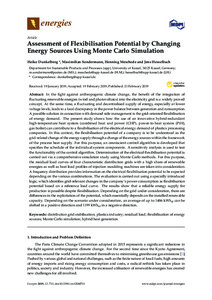| dc.date.accessioned | 2019-05-21T12:26:05Z | |
| dc.date.available | 2019-05-21T12:26:05Z | |
| dc.date.issued | 2019-02-21 | |
| dc.identifier | doi:10.17170/kobra-20190517483 | |
| dc.identifier.uri | http://hdl.handle.net/123456789/11239 | |
| dc.description.sponsorship | Gefördert durch den Publikationsfonds der Universität Kassel | |
| dc.language.iso | eng | |
| dc.rights | Urheberrechtlich geschützt | |
| dc.rights.uri | https://rightsstatements.org/page/InC/1.0/ | |
| dc.subject | distribution grid stabilisation | eng |
| dc.subject | plastics industry | eng |
| dc.subject | residual load | eng |
| dc.subject | flexibilisation of energy sources | eng |
| dc.subject | Monte Carlo simulation | eng |
| dc.subject | hybrid heat generation | eng |
| dc.subject.ddc | 500 | |
| dc.title | Assessment of Flexibilisation Potential by Changing Energy Sources Using Monte Carlo Simulation | eng |
| dc.type | Aufsatz | |
| dcterms.abstract | In the fight against anthropogenic climate change, the benefit of the integration of fluctuating renewable energies (wind and photovoltaics) into the electricity grid is a widely proved concept. At the same time, a fluctuating and decentralised supply of energy, especially at lower voltage levels, leads to a local discrepancy in the power balance between generation and consumption. A possible solution in connection with demand side management is the grid-oriented flexibilisation of energy demand. The present study shows how the use of an innovative hybrid-redundant high-temperature heat system (combined heat and power (CHP), power-to-heat system (PtH), gas boiler) can contribute to a flexibilisation of the electrical energy demand of plastics processing companies. In this context, the flexibilisation potential of a company is to be understood as the grid-related change of the energy supply through a change of the energy sources within the framework of the process heat supply. For this purpose, an omniscient control algorithm is developed that specifies the schedule of the individual system components. A sensitivity analysis is used to test the functionality of the control algorithm. Determination of the electrical flexibilisation potential is carried out via a comprehensive simulation study using Monte Carlo methods. For this purpose, the residual load curves of four characteristic distribution grids with a high share of renewable energies as well as heat load profiles of injection moulding machines are taken into consideration. A frequency distribution provides information on the electrical flexibilisation potential to be expected depending on the various combinations. The evaluation is carried out using a specially introduced logic, which identifies grid-relevant changes in the company's power consumption as flexibilisation potential based on a reference load curve. The results show that a reliable energy supply for production is possible despite flexibilisation. Depending on the grid under consideration, there are differences in the exploitation of the potential, which essentially depends on the installed renewable capacity. Depending on the scenario under consideration, an average of up to 1486 kWhel can be shifted in a positive direction and 1199 kWhel in a negative direction. | eng |
| dcterms.accessRights | open access | |
| dcterms.creator | Dunkelberg, Heiko | |
| dcterms.creator | Sondermann, Maximilian | |
| dcterms.creator | Meschede, Henning | |
| dcterms.creator | Hesselbach, Jens | |
| dc.relation.doi | doi:10.3390/en12040711 | |
| dc.type.version | publishedVersion | |
| dcterms.source.identifier | EISSN: 1996-1073 | |
| dcterms.source.issue | Issue 4 | |
| dcterms.source.journal | Energies | |
| dcterms.source.pageinfo | 711 | |
| dcterms.source.volume | Vol. 12 | |

